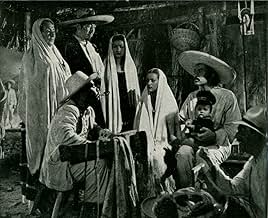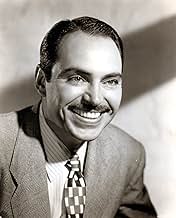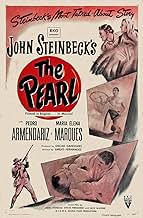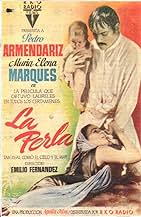IMDb रेटिंग
7.4/10
1.2 हज़ार
आपकी रेटिंग
अपनी भाषा में प्लॉट जोड़ेंThe discovery of a perfect pearl forever changes the lives of a poor Mexican fisherman and his family.The discovery of a perfect pearl forever changes the lives of a poor Mexican fisherman and his family.The discovery of a perfect pearl forever changes the lives of a poor Mexican fisherman and his family.
- पुरस्कार
- 9 जीत और कुल 6 नामांकन
José Arratia
- Tratante de perlas
- (बिना क्रेडिट के)
Guillermo Calles
- Indio rastreador
- (बिना क्रेडिट के)
Enrique Cancino
- Pueblerino
- (बिना क्रेडिट के)
Maria Elena Cuadros
- Juanita
- (बिना क्रेडिट के)
Columba Domínguez
- Pueblerina
- (बिना क्रेडिट के)
Enedina Díaz de León
- Yerbera
- (बिना क्रेडिट के)
Agustín Fernández
- Pueblerino
- (बिना क्रेडिट के)
Rogelio Fernández
- Pueblerino
- (बिना क्रेडिट के)
Raquel García
- Pueblerina
- (बिना क्रेडिट के)
फ़ीचर्ड समीक्षाएं
By the advent of the pearl, everyone appears to be changed in character into a monster of greed, except the protagonists, the fisherman, his wife and their baby, who instead turn into refugees and victims. It's an anatomy of greed with a definite morality, that a great fortune must lead to greed, criminality, death and loneliness. It doesn't have to be like that, but in this story, that is definitely the case in hopeless despair with no illusions surviving, As the pearl enters their lives they start dreaming of all the possibilities it imports, and there is great festivity in the entire village, as all the poor people rejoice in the fisherman's good fortune, but there are always opportunists, and at the appearance of a chance of fortune they will go at any length and sacrifice all human values for their greed. A return to absolute poverty seems to be the only solution to the problem. John Steinbeck's story is a grim study in the weakness of common man, what is lacking here is any wisdom in any man, the fisherman doesn't even have any reliable friend whom he can trust for advice, and the one who helps him gets shot for it. It is impossible not to have objections against such a hopelessly dark and bleak assessment of man, since there must be alternatives. Nothing is completely black, and although the fisherman and his wife survive their via crucis, there must be a new life for them.
Adaptation of John Steinbeck's "The Pearl". I had to read the short novel in junior high. I found it bleak and depressing but powerful. I never even knew there was a film of this until TCM showed it tonight. I was very impressed.
It's a Mexican film and the story was changed to fit into that environment. I never even knew Mexico had a film industry back in the 1940s--films like this are never shown. That's a shame because this film was great. The acting was just OK but that's good--if it had been better acted this might have been unbearable. They didn't lighten up the book or change the ending like Hollywood would have done. And the direction and cinematography were just beautiful--this film should be seen just for the imagery alone. From the opening shot of the women in white robes standing silently by the sea the movie pulls you right in.
This is not for everyone. It's dark and depressing but just great. Despite the change of setting it retains all the power of the short novel. The only debit I could think of was the sometimes intrusive music score--some scenes would have worked much better silently. Still, well worth seeing. I give it an 8.
It's a Mexican film and the story was changed to fit into that environment. I never even knew Mexico had a film industry back in the 1940s--films like this are never shown. That's a shame because this film was great. The acting was just OK but that's good--if it had been better acted this might have been unbearable. They didn't lighten up the book or change the ending like Hollywood would have done. And the direction and cinematography were just beautiful--this film should be seen just for the imagery alone. From the opening shot of the women in white robes standing silently by the sea the movie pulls you right in.
This is not for everyone. It's dark and depressing but just great. Despite the change of setting it retains all the power of the short novel. The only debit I could think of was the sometimes intrusive music score--some scenes would have worked much better silently. Still, well worth seeing. I give it an 8.
The Pearl is directed by Emilio Fernández and John Steinbeck co-adapts his own novella of the same name with Fernández and Jack Wagner. It stars Pedro Armendariz, María Elena Marqués, Fernando Wagner, Gilberto González, Juan García and Charles Rooner. Music is by Antonio Díaz Conde and cinematography by Gabriel Figueroa.
We are in La Paz, Mexico, and when Quino and Juana's son is stung by a scorpion the couple are anguished by not having the finances to pay for medical treatment. Hope springs eternal when Quino discovers a large pearl, something which is seemingly the answer to their prayers - is it?
What we basically have here is a morality play about the corruption of greed. Once the pearl of the title is discovered the ugliness of mankind rears its vile head. People around Quino and Juana - a homely honest but poor couple - suddenly have designs on the financial gains that the pearl can bring - with some of them willing to commit cardinal sins to achieve their aim. The pearl also begins to drive a wedge between the loving couple, and thus we are held enthral of the story to see exactly where this will all end up?
Though it's not very subtle in the telling, with Steinbeck's literary bent often as heavy as a sledgehammer, this is undeniably compelling stuff. That it's also a visual delight also considerably aids the viewing experience. Fernández and Figueroa bring truly atmospheric cinematography into play as a key character of the piece, with kinked frames and low level shots perfectly embracing the discord of the troubling human conditioning on view. Come 1947 what we would come to know as the film noir style of film making was in full effect, fans of such should for sure add The Pearl to their must seek out lists. 8/10
We are in La Paz, Mexico, and when Quino and Juana's son is stung by a scorpion the couple are anguished by not having the finances to pay for medical treatment. Hope springs eternal when Quino discovers a large pearl, something which is seemingly the answer to their prayers - is it?
What we basically have here is a morality play about the corruption of greed. Once the pearl of the title is discovered the ugliness of mankind rears its vile head. People around Quino and Juana - a homely honest but poor couple - suddenly have designs on the financial gains that the pearl can bring - with some of them willing to commit cardinal sins to achieve their aim. The pearl also begins to drive a wedge between the loving couple, and thus we are held enthral of the story to see exactly where this will all end up?
Though it's not very subtle in the telling, with Steinbeck's literary bent often as heavy as a sledgehammer, this is undeniably compelling stuff. That it's also a visual delight also considerably aids the viewing experience. Fernández and Figueroa bring truly atmospheric cinematography into play as a key character of the piece, with kinked frames and low level shots perfectly embracing the discord of the troubling human conditioning on view. Come 1947 what we would come to know as the film noir style of film making was in full effect, fans of such should for sure add The Pearl to their must seek out lists. 8/10
10jotix100
"La Perla", the magnificent 1947 film directed by Emilio "El Indio" Fernandez is a testament to his genius. With the help of one of the greatest cinematographers the world has ever known, Gabriel Figueroa, we are treated to a tale of hope and greed set in the Pacific coast of Mexico. Based loosely on John Steinbeck's story, the author himself, helped enhance his own story with the screen treatment.
We are introduced to Quino and Juana and their infant son, living in poverty. They are starving because the seas have been too turbulent to go pearl fishing. They almost lose the boy that is bitten by a scorpion and the village doctor refuses to take care of the infant since they have no money. The village women nurse him back to health.
When Quino and Juana go fishing, he discovers a large and shiny pearl. This pearl will be their undoing. Quino is hoping for a better life for the boy, so that he doesn't have to lead their precarious life. Fate, on the other hand, intervenes as the beautiful pearl becomes the object of desire for the ruthless dealers, and the doctor, who want to steal it from Quino.
They end up fleeing their village. In a sequence that is as cruel, as it is beautiful, we see the fishers being pursued by the dealer and his Indian searchers, and the doctor through the mangroves first, and the arid countryside later on. Unfortunately, Quino and Juana are robbed of something more precious than the magnificent pearl that has been the object of their downfall.
Mr. Figueroa's cinematography feasts on the magnificent views of the region. The film looks as good today with the excellent copy that must have been restored because it has a pristine quality. Of course, nothing would have been possible with another director because Emilio Fernandez understood the people and was able to present his story in pure cinematic terms.
Pedro Armendariz, as Quino, makes one of the best appearances of his distinguished film career. He was an actor that clearly knew his subject and understood the man he was portraying. Maria Elena Marques is right as Juana, the caring woman and mother. Mr. Armendariz and Ms. Marques gave more than life to this couple.
What seems hard to understand was the casting of Charles Rooner as the evil doctor, or Fernando Wagner, as the crooked dealer, for that matter. Both speak Spanish with a heavy French accent, something that doesn't feel right, but maybe, on the other hand, the director and the writers felt that by having foreigners try to cheat Quino and Juana set the right tone for the story.
Also, the insertion of the fiesta sequence, while lovely to look at, it seems something right out of the Ballet Folklorico and too elaborate for the conditions in which most of the fishermen lived! It's nice to have heard a stylized version of La Bamba, but somehow, it distracts from reality.
"La Perla" was a monumental achievement thanks to Mr. Fernandez's and Mr. Figueroa's inspired take on the Steinbeck story.
We are introduced to Quino and Juana and their infant son, living in poverty. They are starving because the seas have been too turbulent to go pearl fishing. They almost lose the boy that is bitten by a scorpion and the village doctor refuses to take care of the infant since they have no money. The village women nurse him back to health.
When Quino and Juana go fishing, he discovers a large and shiny pearl. This pearl will be their undoing. Quino is hoping for a better life for the boy, so that he doesn't have to lead their precarious life. Fate, on the other hand, intervenes as the beautiful pearl becomes the object of desire for the ruthless dealers, and the doctor, who want to steal it from Quino.
They end up fleeing their village. In a sequence that is as cruel, as it is beautiful, we see the fishers being pursued by the dealer and his Indian searchers, and the doctor through the mangroves first, and the arid countryside later on. Unfortunately, Quino and Juana are robbed of something more precious than the magnificent pearl that has been the object of their downfall.
Mr. Figueroa's cinematography feasts on the magnificent views of the region. The film looks as good today with the excellent copy that must have been restored because it has a pristine quality. Of course, nothing would have been possible with another director because Emilio Fernandez understood the people and was able to present his story in pure cinematic terms.
Pedro Armendariz, as Quino, makes one of the best appearances of his distinguished film career. He was an actor that clearly knew his subject and understood the man he was portraying. Maria Elena Marques is right as Juana, the caring woman and mother. Mr. Armendariz and Ms. Marques gave more than life to this couple.
What seems hard to understand was the casting of Charles Rooner as the evil doctor, or Fernando Wagner, as the crooked dealer, for that matter. Both speak Spanish with a heavy French accent, something that doesn't feel right, but maybe, on the other hand, the director and the writers felt that by having foreigners try to cheat Quino and Juana set the right tone for the story.
Also, the insertion of the fiesta sequence, while lovely to look at, it seems something right out of the Ballet Folklorico and too elaborate for the conditions in which most of the fishermen lived! It's nice to have heard a stylized version of La Bamba, but somehow, it distracts from reality.
"La Perla" was a monumental achievement thanks to Mr. Fernandez's and Mr. Figueroa's inspired take on the Steinbeck story.
10whpratt1
Some how I over looked this John Steinbeck brief story years ago and loved this 1947 production and the fantastic acting. The film is great in black and white and it clearly shows the poverty of local fishermen and their hard tasks of having to dive only when the ocean was calm. Pedro Armendariz,"From Russia With Love",'63 and Maria Elena Marques,"Pueblilo",'62, gave an outstanding performance as husband and wife who have to deal with finding a great treasure and having to face the hard facts of many people who want to share their wealth. Charles Rooner,(Doctor),"Silent Fear",'56 plays a very horrible doctor who seems to hate the local fishermen and wants to treat only the rich who will be able to pay his medical fees. This is truly a great film, which was very well produced and a great Film Classic from the late 40's. Enjoy
क्या आपको पता है
- ट्रिवियाEmilio Fernández, who was in love with Olivia de Havilland, thought she was the ideal actress to play the female starring role. De Havilland never knew of his secret love, but the director was able to get the government of Mexico City to change the name of the street he grew up on to "Dulce Olivia" (Sweet Olivia).
- भाव
Narrator: This is a story that old men tell to children. They aren't sure where it happened or when.
- इसके अलावा अन्य वर्जनA short version (77') was shown in the USA, France and West Germany whereas a longer version (85 to 87') was shown in Mexico and East Germany.
टॉप पसंद
रेटिंग देने के लिए साइन-इन करें और वैयक्तिकृत सुझावों के लिए वॉचलिस्ट करें
- How long is The Pearl?Alexa द्वारा संचालित
विवरण
- चलने की अवधि1 घंटा 25 मिनट
- रंग
- पक्ष अनुपात
- 1.37 : 1
इस पेज में योगदान दें
किसी बदलाव का सुझाव दें या अनुपलब्ध कॉन्टेंट जोड़ें

























